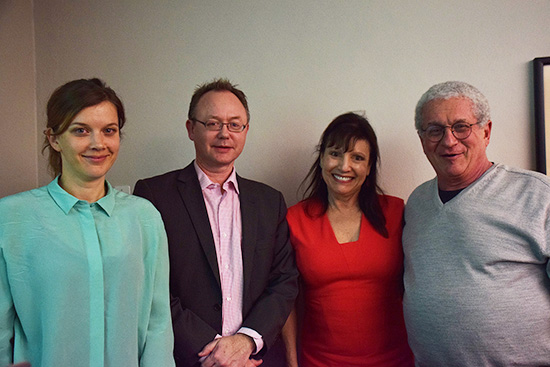Greenberg Fellow Julia Werner Connects Photography to Testimony


From left: Julia Werner, Wolf Gruner, Margee Greenberg, Douglas Greenberg
Julia Werner, the 2015/2016 Margee and Douglas Greenberg Research Fellow, finished up her two-and-a-half week visit to USC Shoah Foundation Center for Advanced Genocide Research last Thursday with a talk, “Beyond the Pictorial Frame: Ghettoization of the Jews in Poland,” on her research.
In 2014, Douglas Greenberg, the former executive director of USC Shoah Foundation, along with his wife Margee, established an endowed fellowship that supports a scholar coming to the Institute for up to a month to utilize the Visual History Archive for his or her dissertation research. Werner is the second scholar to be selected.
Werner is a Ph.D. candidate from Humboldt University in Berlin doing her thesis on photography during national socialism. During her time in Los Angeles, she focused on the actual moment of the ghettoization of the Jewish population in Poland, mainly by matching up images taken by amateur German photographers that she had previously studied with testimony from the Visual History Archive.
“The photographs, because they’re photos by German perpetrators or these bystanders, are the majority on an aesthetic level documentary; they try to kind of document and capture the process,” Werner said. “And the interviews, on the other hand, they help really to refine the context and also give a much better understanding of the complete view of the individuals who were subjected to this force.”
Many of the photos Werner highlighted during her talk focused on Kutno, a Polish town where Jews were moved to an empty open air space on the grounds of an abandoned sugar factory. Amateur German photographers had captured images of the Jews moving their belongings the two kilometers from the city center to the ghetto and what life was like there.
“Visually, this moment of transfer has not been a part of this established group of images [from Holocaust ghettos] that are published again and again,” Werner said.
One moment Werner was able to connect the dots between the photos and the testimony was when she came across a man speaking about helping to run a barber’s stand in the ghetto and realized she also had a picture of a barber at work.
“The connection of the photographic sources with the testimony allows the viewer to look outside the pictorial frame and give an idea of what happened outside the picture and also afterwards,” she said of that discovery and others she had during her time at USC Shoah Foundation.
Werner also said that listening to individuals’ testimony helped her see Kutno’s Jews as a diverse array of people, rather than one group as the Germans treated them in their photographs. Testimony also informed her about the violence of the move that was absent from the photographs.
“The photographs make the individuality of the people photographed invisible,” she said. “What they also make invisible is the force of violence in the move. On the one hand you don’t see acts of physical violence and, also, in none of the pictures are Germans in uniform. So, it almost seems that the process was set in motion by the people themselves.”
One issue Werner appeared to struggle with was if, by looking at the photographs today, people are still adding to the violence imposed on these individuals.
“Just the mere act of taking a photo in that situation adds another layer of violence to it,” she said. “Photography or the creation of representation of this situation of this forced move extends the act of violence basically until today.”
However, she said studying these individuals past their representation in the photos has helped with this.
“Only by going beyond the pictorial frame can you bring back the voice or the agency of the people who were being photographed,” she said.
Like this article? Get our e-newsletter.
Be the first to learn about new articles and personal stories like the one you've just read.